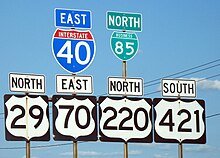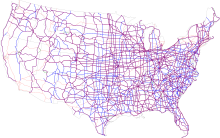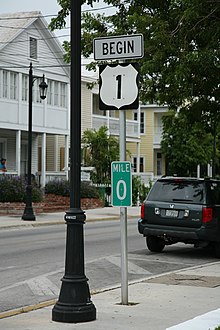United States Numbered Highway System

The United States Numbered Highway System (often US Routes or US Highways ) is a highway system in the United States . It is supplemented by the motorway-like interstate highways and is comparable to federal highways in Germany or Austria.
The highways of the Numbered Highway System usually run through several US states and are not infrequently several thousand kilometers long. However, these roads are not federally administered, but rather by the individual states. The American Association of State Highway and Transportation Officials (AASHTO) is responsible for coordination .
system

The interstate highways are subordinate to the US highways, and the state routes managed autonomously by each state are subordinate .
The US Highways trunk road system was 169,760 miles (273,202 km) in length in 1955. By 1989, when the AASHTO last published its Route Log , the total route length had fallen slightly to 159,645 miles (253,832 km), due to the downgrading of various highways to state routes. The AASHTO emphasizes that the US highways are not a substitute for the state routes that are managed autonomously by the states, but complement them in a meaningful way to make car journeys across the borders of the individual states comfortable and with clear landmarks.
In contrast to the interstate highways, which are designed as freeways and therefore do not have any elements that hinder the free movement, such as traffic lights or level crossings , there are no structural minimum requirements for US highways. They often have intersections and junctions with or without traffic lights, and unlike interstate highways, they rarely have entrances and exits.
The terms US Highway and US Route are synonymous and are used side by side. The regularly published report of the AASHTO is entitled United States Numbered Highways , while the highways are sometimes referred to as US Routes in the text , including in the table of contents of the publication. The states also use both terms, for example Delaware uses the term US Routes while Colorado uses the term US Highways .
The most well-known trunk road in the US Highway System is probably US Route 66 , which was one of the first continuously paved roads across the United States to be of great economic importance.
numbering
At the beginning of the 20th century, important highways did not have numbers, but names; the streets were often named after great figures in US history. Two of the most important highways at the time were the Lincoln Highway and the Jefferson Highway . From 1918 the systematic numbering of important highways slowly gained acceptance, in 1924 the AASHTO decided on a nationwide uniform system for numbering (see section History ).
The highways of the Numbered Highway System are given an individual number and are then referred to as US Highway or US Route in conjunction with this number. Basically, highways in a north-south direction are assigned odd numbers and numbers increasing from east to west, while highways running in a west-east direction are assigned even numbers, with numbers increasing from north to south. The most important highways in north-south orientation end with a 1, while those in west-east orientation have 0 as the last digit. Feeders for highways are given a three-digit number, with the last two digits corresponding to the number of the associated highway. There are, however, some exceptions to this system (for example, because corresponding numbering was not available or due to changes in the system in the historical course).
Additional terms such as "Alternate Routes" as official alternative routes, which are hierarchically subordinate to the main routes, or "Bypass Routes" have also emerged, mostly from historical points of view. The letters A and B are often used as suffixes for this. Some US highways of particular historical or scenic importance are classified as National Scenic Byway .
history

In 1903, Americans drove Horatio Nelson Jackson and Sewall Crocker with its passenger cars , a Winton 1903, from San Francisco to New York City . Since there were only about 150 miles (230 km) of paved roads in the whole of the United States at the time, Jackson and Crocker mostly used unpaved country roads and train routes for this trip . Your project quickly received a lot of attention in various daily newspapers and developed into a sensation that received attention across the country. Today, the trip is considered the first documented car tour across the United States. At the same time, this tour gave rise to the first considerations to systematically build highways in the USA. From 1910 onwards, various locally organized organizations and interest groups emerged to build highways between different large cities. Financing and construction were decentralized, for example by the municipalities themselves; a standardized road construction did not yet exist at this time. Since the number of registered motor vehicles between 1910 and 1920 almost exploded from 500,000 vehicles to over ten million vehicles, a great need arose for a systematic design and naming of the highways. In 1914, the American Association of State Highway Officials was established. The Federal Aid Road Act of 1916 regulated road construction funding nationwide and provided $ 75 million for road construction between 1916 and 1921, greatly accelerating the development of the highway network.
The first state in the United States to systematically number its highways was Wisconsin in 1918. A year earlier, the Wisconsin Parliament had decided to build a well-developed network of highways. After initial considerations of color coding the highways had been discarded, Wisconsin systematically assigned numbers for the highways: starting with the number 10 for the longest highway, the highways were given two-digit numbers in the order of their length. The system of numbered highways quickly proved to be very reliable and was adopted by other states.
At a meeting of the American Association of State Highway Officials in 1924, the state departments of transportation decided on a uniform numbering system for interstate highways . The details of this system were decided in further meetings. In 1925 they agreed on the prefix "US Highway" in connection with a number. In addition, the highways that will be part of this highway system were selected. A road network totaling 75,800 miles (122,000 kilometers) in length was selected. At the time, this represented a share of 2.6% of all roads in the United States. The resolutions led to extensive discussions nationwide and met with approval and rejection in local daily newspapers - often depending on whether the respective region was on the highway. System was connected or not. The plan was finally officially adopted on November 11, 1926. The numbering system adopted is largely still in force today.
In the following years, the AASHTO tried to resolve existing inconsistencies and changed the number of highways, which had the character of a feeder , to three-digit numbers by placing a number in front of the existing two-digit numbering. In addition, “Alternative Routes” were defined. With the extension of various highways and the construction of new roads, the system became more and more complicated, so that, especially in the early 1960s, some extensive renaming became necessary. The AASHTO is still working to remove highways from the highway system that have a total route length of less than 300 miles and that do not connect any states.
In 1956, then- President of the United States , Dwight D. Eisenhower , enacted the Federal Aid Highway Act . This law passed the construction of the US Interstate Highway System . Interstate highways are national expressways, comparable to motorways . By 1991, over $ 100 billion had been invested in the 77,000-kilometer expressway network. The Interstate Highway System replaced the highway system as the most important highway system in the United States. Interstate highways also have a numbering system, but have an I- as a prefix .
literature
- Dan McNichol: The Roads That Built America . The Incredible Story of the US Interstate System. Sterling Pub, New York City 2005, ISBN 978-1-4027-3468-7 (English).
Web links
- American Association of State Highway and Transportation Officials: Official website (English)
- American Association of State Highway and Transportation Officials: Establishment and Development of United States Numbered Highways , excerpt from the AASHTO Transportation Policy Book , January 2000
Individual evidence
- ↑ American Association of State Highway and Transportation Officials (AASHTO): United States Numbered Highways . 1989, p. IV (English). Archive version available online ( Memento from January 1, 2014 in the Internet Archive )
- ^ A b American Association of State Highway and Transportation Officials (AASHTO): United States Numbered Highways . 1989, p. V (English). Archive version available online ( Memento from January 1, 2014 in the Internet Archive )
- ↑ Dayton Duncan: Horatio's Drive: America's First Road Trip . Knopf Verlag, 2003, ISBN 978-0-375-41536-4 (English).
- ^ A b c d e Richard F. Weingroff: From Names to Numbers: The Origins of the US Numbered Highway System - General Highway History. United States Department of Transportation , Federal Highway Administration , accessed April 27, 2017 .
- ↑ a b 1964 California Highway Renumbering. In: gbcnet.com. Retrieved April 27, 2017 (English).


